This is a Leanpub book. Leanpub empowers authors and publishers with the Lean Publishing process. Lean Publishing is the act of publishing an in-progress ebook using lightweight tools and many iterations to get reader feedback, pivot until you have the right book and build traction once you do.
This book is dedicated to my wife, Natalie, and my children.
Editing by Margie Newman and Katherine Geerling. Cover photograph and illustration 2011 Jeff Geerling.
Ansible is a software product distributed under the GNU GPLv3 open source license.
Foreword
Over the last few years, Ansible has rapidly become one of the most popular IT automation tools in the world. Weve seen the open source community expand from the beginning of the project in early 2012 to over 1200 individual contributors today. Ansibles modular architecture and broad applicability to a variety of automation and orchestration problems created a perfect storm for hundreds of thousands of users worldwide.
Ansible is a general purpose IT automation platform, and it can be used for a variety of purposes. From configuration management: enforcing declared state across your infrastructure, to procedural application deployment, to broad multi-component and multi-system orchestration of complicated interconnected systems. It is agentless, so it can coexist with legacy tools, and its easy to install, configure, and maintain.
Ansible had its beginnings in 2012, when Michael DeHaan, the projects founder, took inspiration from several tools he had written prior, along with some hands-on experience with the state of configuration management at the time, and launched the project in February of 2012. Some of Ansibles unique attributes like its module-based architecture and agentless approach quickly attracted attention in the open source world.
In 2013, Said Ziouani, Michael DeHaan, and I launched Ansible, Inc. We wanted to harness the growing adoption of Ansible in the open source world, and create products to fill the gaps in the IT automation space as we saw them. The existing tools were complicated, error-prone, and hard to learn. Ansible gave users across an IT organization a low barrier of entry into automation, and it could be deployed incrementally, solving as few or as many problems as the team needed without a big shift in methodology.
This book is about using Ansible in a DevOps environment. Im not going to try to define what DevOps is or isnt, or whos doing it or not. My personal interpretation of the idea is that DevOps is meant to shorten the distance between the developers writing the code, and the operators running the application. Now, I dont believe adding a new DevOps team in between existing development and operations teams achieves that objective! (Oops, now Im trying for a definition, arent I?)
Well, definitions aside, one of the first steps towards a DevOps environment is choosing tools that can be consumed by both developers and operations engineers. Ansible is one of those tools: you dont have to be a software developer to use it, and the playbooks that you write can easily be self-documenting. There have been a lot of attempts at write once, run anywhere models of application development and deployment, but I think Ansible comes the closest to providing a common language thats useful across teams and across clouds and different datacenters.
The author of this book, Jeff, has been a long-time supporter, contributor, and advocate of Ansible, and hes maintained a massive collection of impressive Ansible roles in Galaxy, the public role-sharing service maintained by Ansible, Inc. Jeff has used Ansible extensively in his professional career, and is eminently qualified to write to the end-to-end book on Ansible in a DevOps environment.
As you read this book, I hope you enjoy your journey into IT automation as much as we have. Be well, do good work, and automate everything.
Tim Gerla
Ansible, Inc. Co-Founder & CTO
Preface
Growing up, I had access to a world that not many kids ever get to enter. At the local radio stations where my dad was chief engineer, I was fortunate to get to see networks and IT infrastructure up close: Novell servers and old Mac and Windows workstations in the 90s; Microsoft and Linux-based servers; and everything in between. Best of all, he brought home decommissioned servers and copies of Linux burned to CD.
I began working with Linux and small-scale infrastructures before I started high school, and my passion for infrastructure grew as I built a Cat5 wired network and a small rack of networking equipment for a local grade school. When I started developing full-time, what was once a hobby became a necessary part of my job, so I invested more time in managing infrastructure efficiently. Over the past ten years, Ive gone from manually booting and configuring physical and virtual servers; to using relatively complex shell scripts to provision and configure servers; to using configuration management tools to manage many cloud-based servers.
When I began converting my infrastructure to code, some of the best tools for testing, provisioning, and managing my servers were still in their infancy, but they have since matured into fully-featured, robust tools that I use every day. Vagrant is an excellent tool for managing local virtual machines to mimic real-world infrastructure locally (or in the cloud), and Ansible the subject of this book is an excellent tool for provisioning servers, managing their configuration, and deploying applications, even on my local workstation!
These tools are still improving rapidly, and Im excited for what the future holds. The time I invest in learning new infrastructure tools well will be helpful for years to come. (Ansible, Docker, and Vagrant seem a potent combination for both local and production infrastructure, but thats a little outside of this books scope.)
In these pages, Ill share with you all Ive learned about Ansible: my favorite tool for server provisioning, configuration management, and application deployment. I hope you enjoy reading this book as much as I did writing it!
Jeff Geerling, 2015
Who is this book for?
Many of the developers and sysadmins I work with are at least moderately comfortable administering a Linux server via SSH, and manage between 1-100 servers.
Some of these people have a little experience with configuration management tools (usually with Puppet or Chef), and maybe a little experience with deployments and continuous integration using tools like Jenkins, Capistrano, or Fabric. I am writing this book for these friends who, I think, are representative of most people who have heard of and/or are beginning to use Ansible.
If you are interested in both development and operations, and have at least a passing familiarity with managing a server via the command line, this book should provide you with an intermediate- to expert-level understanding of Ansible and how you can use it to manage your infrastructure.
Typographic conventions










